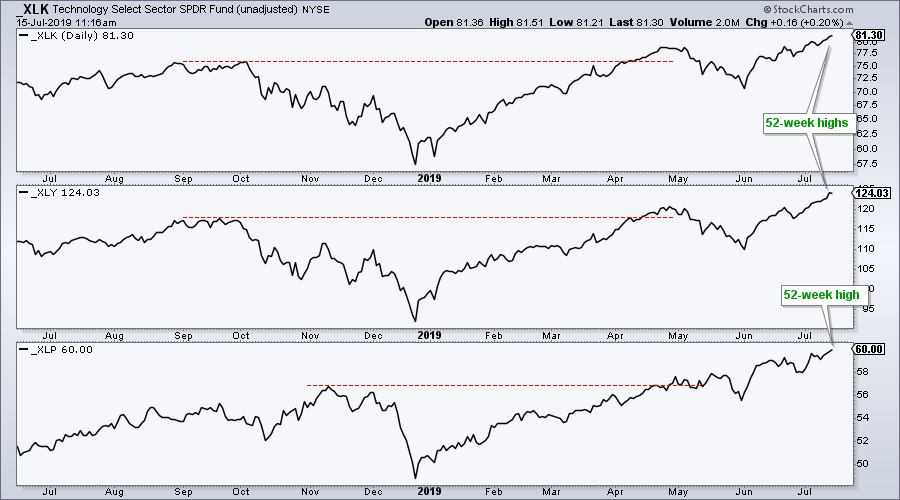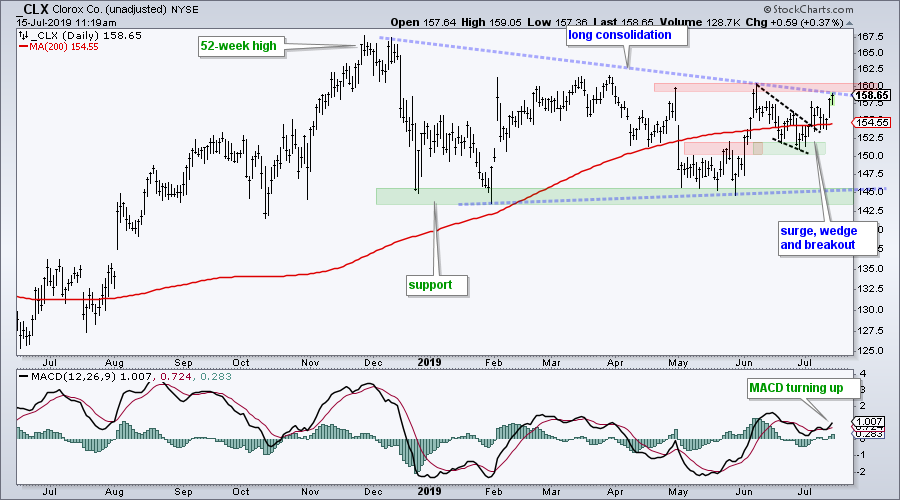The S&P 500 hit a new 52-week high last week and three sectors joined the index with new highs of their own: the Technology SPDR, the Consumer Discretionary SPDR and the Consumer Staples SPDR. Note that I am basing the new highs on price chart using unadjusted prices, which do not include dividends. StockCharts users can place an underscore before the symbol to see unadjusted prices (_XLK, _XLY, _XLP).
One of these three sectors does not belong in this group. The technology and consumer discretionary sectors are offensive sectors, but the consumer staples sector is a defensive sector. I do not consider it bearish for the broader market when a defensive sector leads because we are also seeing leadership from the largest sector and the most economically sensitive sector. XLK accounts for 21.64% of the S&P 500, while XLY weighs in at 10.37% and XLP at 7.31%.
Clorox (CLX) caught my eye when running through the charts within the S&P 500. The stock is part of a strong sector (consumer staples), in a long-term uptrend and forming a bullish continuation pattern. First and foremost, CLX hit a new high in late November and recaptured its rising 200-day SMA with a bounce off support in June. Despite a long consolidation, the overall trend appears to be up.
After hitting a 52-week high in late November, the stock embarked on a long consolidation or trading range. This consolidation worked off overbought conditions from late November and set the stage for the next move, which appears to be higher. A consolidation after an advance is typically a bullish continuation pattern. Moreover, there are signs of a pending breakout.
The stock surged off the 155 support zone in early June and broke a resistance level in the 151-152 area. The subsequent pullback formed a falling wedge and CLX broke the wedge line with surge here in July. The trend within the larger consolidation is up and this argues for a bigger breakout in the 160 area. Such a breakout would signal a continuation of the bigger uptrend and target a move to new highs.
On Trend on YouTube
Charting Robust AD Lines and AD Volume Lines: The NYSE and Nasdaq are fine as exchanges, but their respective breadth indicators are not representative of the stock market. Today we will take an in depth look at the components of the Nasdaq and NYSE, and chart their spurious AD Lines. We will then turn to index specific AD Lines and AD Volume Lines that better reflect the market as a whole. And finally, we will finish with a breadth troika using S&P 1500 indicators that investors can use to time the broader stock market. Click here to Watch
Arthur Hill, CMT
Senior Technical Analyst, StockCharts.com
Book: Define the Trend and Trade the Trend
Paper: RSI for Trend-Following and Momentum Strategies
Want to stay up to date with the latest market insights from Arthur?
– Follow @ArthurHill on Twitter
– Subscribe to Art's Charts
– Watch On Trend on StockCharts TV (Tuesdays / Thursdays at 10:30am ET)








